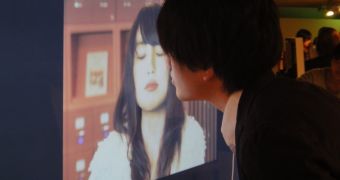Japanese inventors either have too many ideas or just don't know what to do with their time. Why else would they actually come up with interactive posters, of all things?
Still, reality is reality: a research group from the Keio University has invented a technology that lets a photo of a person react when kissed.
Their aim is to create posters which, based on motion sensing, will appropriately (or inappropriately, depending on one's view) respond.
“This system is very simple. There's an ultrasound sensor here, to detect how far away your head is. As you approach the sensor, the picture changes. When you get closer, the picture becomes a kissing face, and when you move away, it becomes a blushing face,” says one of the team's members.
“I'm a big fan of pop idols, and I have posters of them in my room. It bugged me that the posters didn't move at all. We built this system because we thought, if a poster could move to match people's movements, that would be interactive and fun.”
We can't exactly see how appropriate it is for a poster to kiss you back when you make a move on it.
After all, one has to wonder how the one pictured there would feel about it, and if it counts as flirting (or having an affair) with the entire fan base at once.
Regardless, an iPad app will be the first to come. The reaction to it will determine if anything else becomes of the idea.
“We think we could get pop idols to actually pose for this, and sell it as an application, or it could be used in digital signage. I think people would be really attracted by a face that gives a kiss as they walk past,” the team said.
“The current system only produces visual changes, but we could also include the scent of shampoo from the person's hair, or a lemon-flavored film on the lips, or a speaker that whispers 'I love you.' People who've tried this system advised us to do those things, so we think there's still plenty to be done. We've learned a lot from talking to users.”

 14 DAY TRIAL //
14 DAY TRIAL //